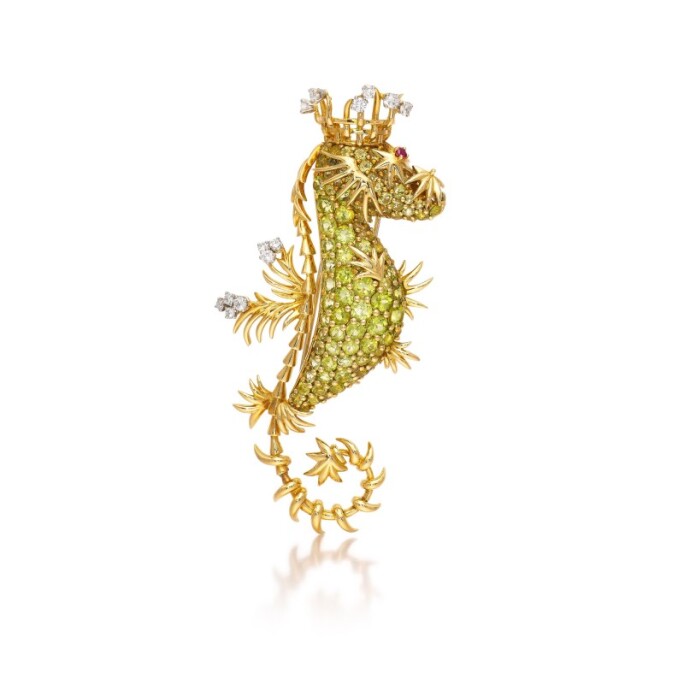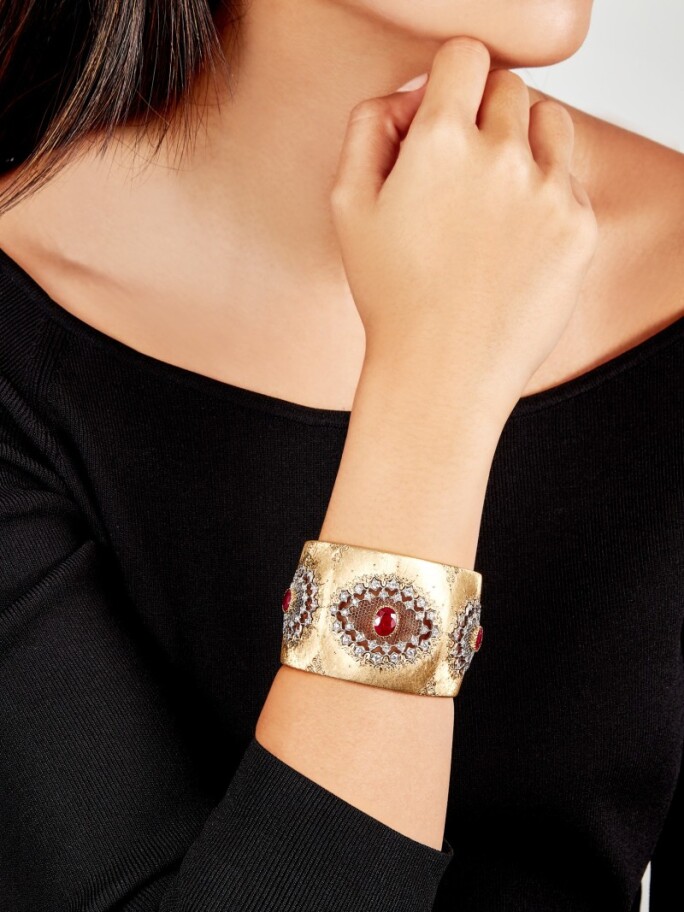J ewellery is one of the oldest and most universal art forms. From simple pieces such as stud earrings to an extravagant diamond necklace, every jewel is wearable sculpture, a mode of creative expression, each telling its own story through the interaction of precious materials and the human body. Through head ornaments, brooches, earrings, necklaces and rings, the adorned bodies can be transformed, accentuated or amplified in such a way that they may become living expressions of art.


Beauty, power, and divinity – the ideas which have influenced great artists throughout history have also guided the designers of magnificent jewels. In the late-19th century, the emergence of the Vienna Secession saw a moment that questioned the traditional understanding what constitutes art – blurring the lines separating fine art and decorative art. Later, artists from all disciplines would embrace multiple forms of expression, and famous artists from the Bauhaus, Surrealist and Cubist movements began experimenting with their art in 3D – moving their way into jewellery design. Thus, the idea of ‘wearable art’ was conceived, creating an outlet from the conventions of traditional jewellery allowing these artists to create unique designs, often with sculptural qualities. In this respect, the distance between sculpture and jewellery are not so far apart. The intention to give expression to the energy of nature – such as flowers, wildlife and the ocean – or to integrate the geometries and embellishments of architectural styles have been a key inspiration. With examples from the upcoming Magnificent Jewels: Part I & II auctions, we look at some of history’s most important designers who created jewels as masterpieces of wearable art.
Cartier
With a roster of visionary designers such as Charles Jacqueau, Pierre Lemarch and enigmatic creative director Jeanne Toussaint, Cartier’s designs articulated a wide range of influences into highly original and elegant jewels that defined their eras. In the famous working relationship between Louis Cartier and Toussaint, Cartier imparting his knowledge of gemstones, diamonds, settings and technique, and Toussaint bringing her joie de vivre, relentless creativity and eye for contemporary fashions, especially the graphic and geometric Art Deco movement. Their ‘Tutti Frutti’ pieces brought carved emeralds, rubies and sapphires adapted from Indian jewels together in riotous combination from the mid 1920s, while their opulent ‘big cat’ jewels draped themselves across such legendary collectors as Barbara Hutton and the Duchess of Windsor. The Deco Period ushered in Cartier’s beloved menagerie of jewelled animals, including the famed panther, followed by, elephants, giraffes, and exotic birds – spellbinding creations that romanticised the splendour of Africa.
Van Cleef & Arpels
The signature style of Van Cleef & Arpels would draw from multiple influences, combining nature, high fashion, exoticism, talismans, and fantasy, as well as the important innovation of the ‘invisible setting’, a technique of virtuoso gem-cutting and setting perfected by Van Cleef & Arpels. Each stone would be specially cut on the side with tiny grooves, so that the interlocking angled edges can be pressed tightly together onto a framework of gold rails to create a mosaic. The effect is an uninterrupted surface of intense color with no visible prongs or fittings holding the stones in place, which lent itself to floral and foliate designs. The house epitomised glamour, spirit and modernity of the Art Deco era that its creations are regarded as masterpieces of late 20th-century design.
“Art is a discovery and development of elementary principles of nature into beautiful forms suitable for human use.”
Tiffany
Jean Schlumberger is an artist who created sculptures of mesmerizing beauty. His designs were influenced by the flora, fauna, and architecture around him, infused them with his individualistic brand of wit and curiosity, and finding beauty in some of the most mundane shapes and materials. With parents who were prosperous textile manufacturers, the self-taught designer wound up in Paris where he got his start at an art publishing company, became involved with the Surrealists, and designed accessories for Elsa Schiaparelli. The highly imaginative work shone through in his jewellery design as well as with a variety of media. In New York, Schlumberger became legendary for his iconic creations for Tiffany & Co. Whimsical interpretations of wildlife and botanical subjects, his works famously saw the wonder in the movement and irregularity of nature.
Boucheron
One of the great Parisian heritage Maisons, Boucheron was founded in Paris in 1858 by Frédéric Boucheron (1830-1902), whose innovations have made his works a favourite among the royalty, nobility and the illustrious in the extravagant luxury-loving Second Empire, with an illustrious international clientèle. Boucheron collaborated with the designers Jules Debut, Paul Legrand and Lucien Hirtz, with the noted chaser and engraver, Louis Armand Rault, and the enameller, Charles Riffault. Boucheron fostered the revival of plique à jour, a lost art of enamelling from the Renaissance. Riffault's richly-coloured pieces remained a speciality of the Maison. Boucheron also elevated jewellery making to an aret form, celebrated for sculptural gold modelling, for engravings on diamonds, and for exquisitely engraved and inlaid steel.
Buccellati
Inspired by elements such as Venetian lace, Etruscan patterns, Italian vegetation, insects and animals, the singular designs of family firm Buccellati have gained international acclaim since its founding more than 100 years ago. It was Italian jeweller Mario Buccellati, taken with the splendour of Greek and Renaissance art, who formed the Buccellati style by merging ancient goldsmithing techniques, such as engraving and chiselling, with an expert use of white and yellow gold. These rich textures brought Buccellati designs to life by imitating linen, imparting a lustrous sheen, or featuring embellished leaves and flowers. Jewellery from the Italian heritage brand still bear its trademark blend of delightfully unexpected colour combinations and varied textures.
JAR
Joel Arthur Rosenthal’s initials make up the unassuming name JAR, and working in Paris under this monogram, it has become the by-word for the ultimate in near-untouchable artistry in gems and precious metals. Since Rosenthal began creating his own designs in the 1980s, he has elevated his craft to the level of a true art form, introducing a depth of meaning, cultural layers, beauty and a poetry and poignancy that had been missing in precious jewellery for decades. The first living jeweller to have a solo exhibition at The Metropolitan Museum of Art, JAR was described by the museum as a ‘contemporary artist of gems’, known for his painterly selection of gem-colour, mixing stones to creates subtle gradations or vibrantly arresting contrasts. Deliberately disregarding traditional notions of rarity, he selects each stone for its singular beauty, tone, fire, sheen – and painstakingly arranges them in intricate compositions that express the natural idiosyncrasies of organic shapes or floral patterns in such a way to bring his creative visions to life.
“A jewel, a work of art is a presence that reminds us of the importance of emotion, of life, of our values and ideals.”
And what of the extraordinary pieces made by artists whose names have been lost to time – the lapidaries, enamellists, smiths or carvers of extraordinary skills sent to serve ateliers in imperial or royal palaces? Or the vintage unsigned works of great beauty? Such sculptural masterpieces can impart might impart the same raw power of form and emotion as a work by Michelangelo or Rodin. These anonymous master sculptors unlock the inner life of the stone, slowly releasing a dimensional form and ultimately liberating it from within a single block of material. These wearable works of art give a perfect form to our thoughts and experiences, and in the words of Pablo Picasso, “wash away from the soul the dust of everyday life.”





























